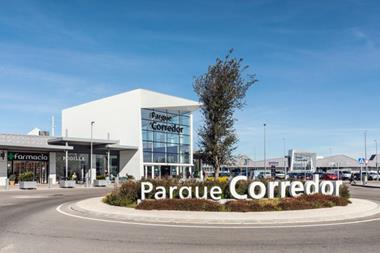It is a great time for borrowers in Germany as the competition for extra lending business heats up further.
It is a great time for borrowers in Germany as the competition for extra lending business heats up further.
German thrift seems to be a thing of the past as the country’s banking sector gears up for a bumper year and lenders jostle for extra business to offset falling loan margins. And in a sign of just how much the market has changed in the past two years, it has never been cheaper – or easier- to borrow.
‘The market is benefitting borrowers more than lenders. It’s a really great time for borrowers,’ said Jörg Schürmann, head of corporate finance at JLL in Frankfurt. ‘I think core margins have reached a plateau. For really good offices in Frankfurt, for example, we’ve seen loan pricing of just 60 bps. It can’t go much lower than that! The five-year swap rate is also only around 20 bps. The all-in interest rate on a five-year loan can be lower than 1%,’ he added.
The existing real estate loan volume in Germany totalled around €240 bn at the end of 2014, according to C&W. This year, that figure is expected to increase by around €30 bn, according to C&W.
However, increasing competition means that ‘the market has got a lot more intense as so many people are trying to lend and yields are still compressing’, said Michael Kröger, head of international real estate finance at Helaba in Frankfurt. ‘For borrowers, it has never been better,’ he said. ‘For core properties with decent LTVs and solid cash flow, we’re seeing loan pricing for some core deals of less than 100 bps – that’s a record low. A year ago, it was typically between 100 bps and 150 bps for core assets. Market fundamentals also pay a role. Germany is one of very few AAA-rated countries in the EU, so our cost of capital is also very low,’ he added.
In April, most of the German lenders who published their financial results for 2014 performed well. However, banks are clearly trying to offset smaller margins by increasing their overall loan volumes, according to Schürmann: ‘We’re seeing loan volumes underwritten by one single bank that we just didn’t see two years ago. Refinancing costs are also much lower.’
At end- April, pbb Pfandbriefbank announced that it had provided €430 mln towards a syndicated loan for real estate manager and developer Aurelis Real Estate. A further €100 mln was provided by an unnamed German bank. Pbb was the lead arranger and agent for the transaction. The loan is already available to Aurelis.
Traditional lenders firmly back in the game
Traditional lenders, some of whom retreated from the real estate game in the wake of the financial crisis to lick their wounds, are now firmly back in the lending game. One of the most active real estate lenders in Germany last year was Aareal Bank, which ratcheted up €10.7 bn in new business, according to a company spokesman. This year, Aareal is hoping to do up to €7 bn in new business, he added, declining to provide further details.
Hot on Aareal’s heels was pbb Pfandbriefbank, which reported €10.2 bn in new business – a new all-time high - of which real estate accounted for €9 bn. Dr. Bernhard Scholz, member of the management board at pbb, told PropertyEU that this year pbb ‘is aiming to slightly exceed that level’. Helaba did over €8 bn in new long-term real estate lending last year and expects to do a similar amount, or slightly less, this year, Kröger said. BerlinHyp did €5 bn in new business last year, including €1bn in extensions, according to a company spokesman, who declined to provide a forecast for this year.
Senior debt funds muscle in on action
One growing trend is the increase in senior debt funds which are jostling for a share of Germany’s lending pie. ‘They are funded by fixed income investors who don’t expect such high returns, so they will accept an IRR of around 2%,’ said Schürmann at JLL. ‘We’ll see how they do but I think there is a place for them, despite stiff competition in the market.’
Deutsche Asset & Wealth Management raised €500 mln for a CRE senior loan fund in January. Structured as a German spezialfond, it invests in German senior commercial real estate loans with LTVs of up to 60% secured against office, retail, residential and logistics assets. Loan maturities range from three-to-10 years.
‘Real estate debt investment is one of the main initiatives we have launched in the last two years,’ said Andrea Vanni, head of European real estate debt investments for Deutsche Asset & Wealth Management. ‘This fund has great flexibility regarding where to invest in Germany– not just the ‘Big 6’ and our plan is to expand beyond Germany into the UK, France, Italy and Spain. We’ve launched the fund this year in response to interest from fixed-income investors who are looking to diversify, given the low bond yield environment today.’ Most of the investors in the fund are German institutional investors, he added.
Six senior debt funds targeting Germany have been launched since 2011, including Deutsche Asset & Wealth Management’s recent €500 mln fund, according to Preqin. The largest one is AXA Real Estate’s CRE2 fund, which stands at €1.85 bn. The fund also invests in other markets, including France, Italy, the Netherlands and Spain, according to Preqin. M&G Investments also has a €897.7 mln debt fund targeting Germany, France and the UK, among other markets. AEW Europe has a €323 mln debt fund which also invests in Germany, the UK and France. In addition, there are a number of other funds that make senior debt investments throughout Germany, although they tend to be diversified funds that invest across a wider geographical focus or which have a broader debt structure focus, according to Preqin.
Although non-traditional lenders such as insurers and debt funds have increased their market share over the past two years to around 10% of the lending market, they are now struggling to keep pace with traditional lenders, according to Schürmann at JLL. Frank Nickel, chairman of corporate finance for the EMEA region at C&W agrees: ‘Margins aren’t high enough for alternative lenders and interest rates are too low for insurers. The average margin is around 105 bps for prime assets in Germany today,’ he said.
Previously, the advantage of alternative lenders was that they would underwrite bigger loans than traditional lenders and offer much longer loan terms of up to 25 years. However, since big banks are going full throttle once again, those competitive advantages have been largely eroded. Nonetheless, there has been a marginal shift in the available lending capacity from non-banks in Europe – up 4% to €145 bn for the 2014-2015 period, according to DTZ.
And alternative lenders still have one ace up their sleeve – their ability to underwrite loans that many banks shy away from, such as stretched senior debt or mezzanine debt. ‘We still do club deals with alternative lenders, especially if we need junior or stretched senior debt, as that is typically provided by them,’ Scholz said.
Consolidation game – more to come?
Aareal acquired rival lender WestImmo from Germany’s ‘bad bank’ Erste Abwicklungsanstalt (EAA) for an all-equity amount of €350 mln in February. The deal represented a discount of roughly 50% to its equity book value, which stood at €575 mln in June 2014. The attraction of the deal was clear: it gives Aareal even greater access to European markets in which it already has a strong presence. WestImmo owned total assets of €8.1 bn at end-March 2015, based on a pro-forma extrapolation. Germany accounts for one-third of the assets, with Western Europe representing another 38% and North America 9%. Aareal’s own loan book comprises 22% of German loans, with an additional 31% in Western Europe and 15% in North America, as of end-September 2014.
‘Consolidation is flavour of the month with economists globally. Of course it could happen in the German banking sector but it’s hard to say whether it actually will,’ Scholz said of pbb.
Aareal, for its part, is open to further acquisitions, a spokesman for the company said. ‘We closely
monitor all relevant developments in our markets. Due to our healthy and robust financial constitution in the current environment, we would always be able to seize opportunities and chances for consolidation if they were a good fit and reflected our strategy of sustainable profitable growth.’
Fate of pbb to be decided this year
Following much speculation in the industry, pbb Deutsche Pfandbriefbank announced in March that is was considering a ‘dual-track process through a trade sale or an initial public offering’. Pbb is fully-owned by state-owned Hypo Real Estate, which is required to sell pbb by the end of this year in order to fulfill a condition imposed by the European Commission for its state bailout at the onset of the financial crisis. Pbb has openly admitted that the deadline is a ‘challenge’, citing the lender’s need to ‘demonstrate the full restoration of its profit potential’. In a statement in March, pbb said: ‘The optimum scenario for the bank and its senior creditors is a transaction that provides pbb with a strongly branded and financially sound parent institution. Such an outcome could offer pbb a number of benefits including potential backing in times of market stress.’
Whatever happens, it will have a big impact on the market, according to one Frankfurt-based analyst who asked not to be identified. ‘I don’t think a rival German lender is likely to buy pbb because the ‘add-on’ element might be too limited,’ he said. ‘However, it could be of interest to an institution looking to use the entire lending platform rather than just acquiring the loans. I think an IPO might make more sense because the German stock market is performing very well,’ he added.
Not everyone agrees. Another analyst told PropertyEU that a sale to a rival ‘makes the most sense’. ‘I’m just not sure that there is enough public interest in an IPO,’ he said. Pbb declined to comment on its ongoing privatization process.
Refinancing gap shrinks
Improved capital values and more aggressive refinancing have also helped to lower Europe’s refinancing gap for 2014-2015, which is down 33% year-on-year to €51 bn, according to DTZ. However, if the negative regulatory impact is also taken into account, it adds an additional €73 bn burden, thereby taking Europe’s gross debt funding gap to €124 bn, or 2% higher, year-on-year, according to DTZ.
And while some countries like Spain, still suffer from net funding gaps, in Germany, the UK and France combined there is now a €45 bn lending surplus, according to DTZ. But refinancing is still not easy to come by for all asset classes, Nickel of C&W warns: ‘It’s still difficult to refinance assets such as hotels and healthcare in Germany. There is big pressure on refinancing,’ he said.
Challenges ahead
Despite the buoyant lending climate, there are challenges ahead for German lenders, including the difficult situation on the capital side for some institutions, uncertainty in the euro zone, not least the looming threat of Greece exiting the euro, as well as currency risk in markets like the UK and the US.
Another challenge is low interest rates and even negative interest rates, according to Kröger. ‘The Euribor could dip to a negative level, which is unheard of, not least because it’s used as a reference rate. Paradoxically, though, there is no such thing as negative funding costs for lenders which creates something of a dilemma,’ he said.
For Scholz at pbb, the biggest challenge is that ‘the spectrum of targeted investments by investors has broadened’. ‘There are tendencies to stretch the lending criteria. It is important for all real estate lenders to draw the line in the right place,’ he said.
Sara Seddon Kilbinger
Correspondent UK and German-speaking countries










